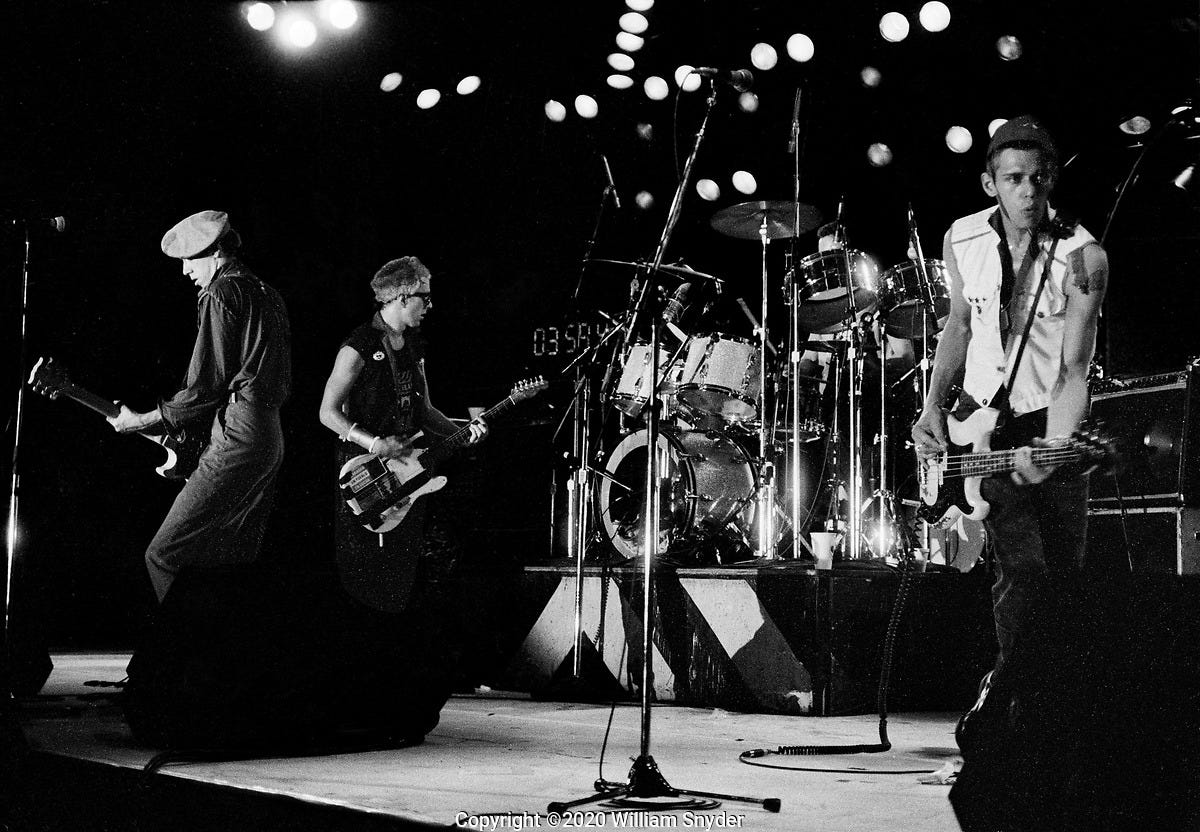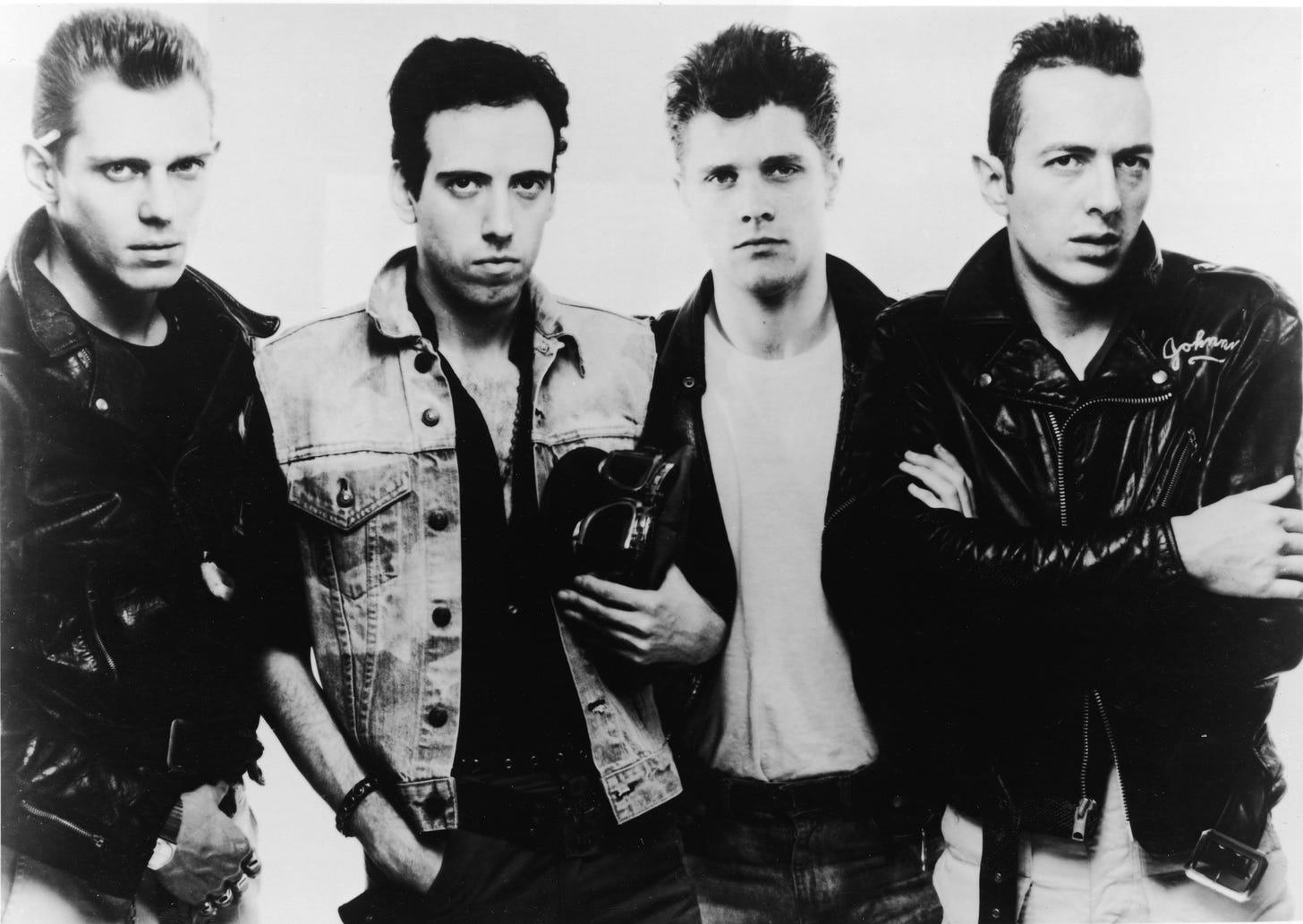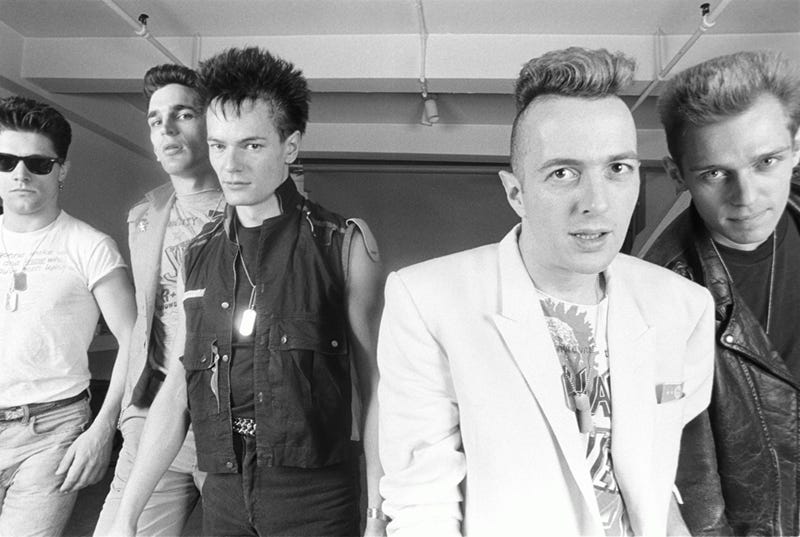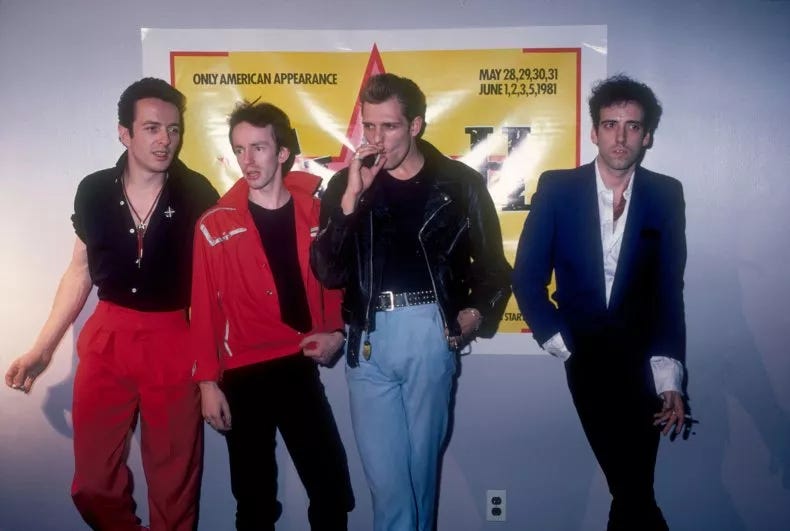Guess my race is run: The end of The Clash
THE CONCLUSION, AT LAST! The Clash glimpse their potential future whilst opening for The Who in America’s Sport-A-Toriums. Then they sack Mick Jones, the group’s founder. Hey, Bernie Rhodes happens….
The 1976 Clash prepare to play Shea Stadium, Oct. 12, 1982.
“We wondered what we were doing playing ‘Career Opportunities’...at Shea Stadium.”
15 days prior to their SNL appearance, the Combat Rock USA Tour’s final leg accommodated several dates on what was supposedly The Who’s farewell US trek. The Clash still headlined plenty of their own gigs in several big city theaters, but most of the next six weeks saw them opening for Ye Olde Guitar Smashers in such Enormodomes as Philadelphia’s JFK Stadium and Detroit’s Pontiac Silverdome. Though Pete Townshend eternally saw The Clash as The Who’s logical successors, presenting them as a sort of manifestation of his old “meet the new boss” lyric, Who fans at times dished out hostility akin to that US Clash fans hurled at their hip hop opening acts. Mojo writer Mat Snow noted booing Philadelphia Who fans pelting the band with apples and bottles, while Seattle embraced them to the point of several adopting “the band’s new dress code of army fatigues and berets.”
The Clash’s Legend places their historical apex at Flushing, Queens’ Shea Stadium on Oct. 12 and 13. Home of the New York Mets, The Who sold out two nights, compared to The Beatles’ record-breaking solitary 1965 show. The “Should I Stay Or Should I Go” video painted the gigs as a triumph for the opening act, depicting The Clash arriving in a rented 1950s Cadillac convertible, the roar of the masses nearly drowning out those two chords.
“Playing Shea Stadium was weird because there were some 90,000 people in there, but at least 10,000 of them are constantly on the move, getting burgers or taking a leak,” Joe Strummer groused in Westway To The World. Mick Jones, for his part, dug it, although he added, “We wondered what we were doing playing ‘Career Opportunities’...at Shea Stadium.”
The Clash at Shea Stadium: “We wondered what we were doing playing ‘Career Opportunities.’”
Terry Chimes saw the friction between the band’s co-leaders with crystal clarity. “Shea Stadium slapped it right in Joe’s face. Was he going down this road or not? He wasn’t comfortable with luxury, while Mick saw nothing wrong with it and enjoyed being a star. You felt those tensions getting worse.”
Paul Simonon recalled the headliners being standoffish, while Townshend frequently hung out in their dressing room, playing football with them. Meanwhile, manager Bernie Rhodes pressed an object lesson on The Clash, starring The Who.
“The Who were very separate people, and I knew them back in the ‘60s, the days of The High Numbers and Kit Lambert,” he explained to Snow. “At Shea Stadium, they had separate limousines, and I said to The Clash, ‘Never, ever be like that group – they might be successful but they hate each other. Never be like those people – you’re different.”
“Mick was all the way over there and I was over here, with Joe in the middle.”
The Mick Jones Clash introduce their new drummer Pete Howard (between Jones and Joe Strummer), 1983.
Rhodes was too late. The Clash were coming apart at the seams, and he was instrumental in fomenting the divisions.
“I really think it was musical differences,” sighed Jones. “Although there was a set-up to cause musical differences. Bernie’s suggestion that we all try to play New Orleans music could have been setting things up so that he could say it was musical differences.”
“I think it was the unexpected success of 'Rock The Casbah,' combined with the fact that we were so tired,” said Strummer. “Tired of each other, tired of the road, tired of the studio. We were burned out. It just blew us apart.”
“I think we were supposed to be going on a tour, but Mick wanted a rest,” surmised Simonon. “I think we should have carried on touring, finished the job we’d started because we were on the verge of making a serious dent. But Mick wanted to go home. That probably caused a lot of frustration for Joe and me.”
Obviously, none of The Clash’s principles agreed on the crash’s cause.
Chimes, for his part, kept pressing Strummer and Simonon on their future plans, eager to cement his return. They continually demurred, claiming they couldn’t predict whether Jones would stay or go. His final date with them was Nov. 27th, 1982, the World Music Festival at Kingston, Jamaica’s Bob Marley Centre in Montego Bay. Bill mates included Rick James, Jimmy Buffet, The English Beat, Yellowman, Rita Marley and the Melody Makers. Upon returning to England, they rested and filmed Hell W10, a silent gangster film written and directed by Strummer, starring The Clash and all their friends. Drummer Pete Howard permanently replaced Topper Headon, debuting on four US dates in Texas and Arizona played en route to Apple Computers founder Steve Wozniak’s massive US Festival. They headlined “New Wave Day” – May 28, 1983 at Glen Helen Regional Park, San Bernardino, CA – over Men At Work, A Flock Of Seagulls, INXS, Wall Of Voodoo, Divinyls, The English Beat, Oingo Boingo, and the Stray Cats.
“The US Festival was a huge gig (for which they were paid $500,000) which Bernie created a lot of friction about,” scoffed Jones. “He kept saying we had to do a press conference (to pressure festival organizers to donate $100,000 to charity), and we were really wound up and didn’t want to do it. We were standing in front of a table with hundreds of press pushing towards us and Joe wouldn’t say a word, he just turned his back. In the end, Bernie was forced to answer questions while we were onstage. It was my last gig, but we were still close onstage,”
Really? According to Simonon, “How we appeared onstage (that night) matched how we were backstage. Mick was all the way over there and I was over here, with Joe in the middle. Mick and I didn’t talk, and Joe was stuck in between.”
“We didn’t have any communication offstage,” admits Jones. “We lost communication with each other, even though we were in the same room. We were looking at the floor and that was it.”
The MTV footage of their set, once they finally stopped throwing a Rhodes-engineered tantrum and got on with it, shows four men on four different planets. They looked like The Clash, and sounded like them, with Howard providing a hard thwack somewhere between Chimes’ fundamentalist hammering and Topper’s creative swing. But the camaraderie and us-against-the-world swagger’s gone. No one looks at one another, no one smiles. Strummer seems especially uptight, ranting at the crowd how they should not blindly accept this rotten capitalist enterprise. He hardly sounded terribly convincing, considering his bank account was well-stocked for the first time ever. Rhodes must’ve fed him material.
This was The-Clash-as-we-knew-them’s final gig.
“It’s so gray in London town….”
The Cut The Crap-era lineup of The Clash, 1984.
Back in London, Strummer and Simonon increasingly dealt with “a lawyer who was representing Mick but couldn’t play guitar,” in Simonon’s words. The seams split September 1, 1983. Jones showed up for practice at their Camden Town rehearsal facility. Seated out front: Topper Headon, checking on his former bandmates.
When the singer and bassist finally appeared, they fired Mick Jones from The Clash, the band he founded in 1976. Rhodes egged the others on, winding them up over his transformation into a rock star, emphasizing Jones’ refusal to communicate except through his lawyer.
“There was a power struggle between Bernie and Mick, and I was foolish enough to let Bernie have his way,” lamented Strummer. The problem was, he continued letting Bernie have his way, as the remaining trio drafted in guitarists Vince White and Nick Shepherd into a new, “back-to-basics” street punk lineup of The Clash.
Yep, it took two guitarists to replace Mick Jones.
The new lineup’s dates the next two years reduced everything to a sub-1977 thrash. Even “Rock The Casbah” and new songs such as “We Are The Clash” were reduced to knucklehead guitars and shoutalong football choruses. And The Clash were better than Oi! By the time they got to the studio to document their new sound, Rhodes isolated Strummer from the rest. They pieced together a weird high-tech punk album loaded with ham-fisted synths and drum machines, only bringing in the band to shout along on the chanted chorus or hit some ultra distorted power chords devoid of tone. Only “This Is England” survived Rhodes’ attempt to make The Clash into Sigue Sigue Sputnik. It was that great, the only track the proper Clash deem a proper Clash song. It’s Cut The Crap’s sole saving grace.
A fan’s recent remix of "“We Are The Clash” to resemble how it sounded live.
Fan-shot footage of the end-stage Clash on the 1985 busking tour.
Jones scrubbed lively guest guitar on English Beat offshoot General Public’s wonderful debut single “Tenderness,” before manifesting all his Sandinista! ideas as Big Audio Dynamite. The Clash sputtered to a halt following an impromptu busking tour of England and Cut The Crap’s release. Simonon played in Havana 3AM with Gary Myrick, eventually abandoning music for his first love, painting. Strummer seemed lost, shouldering truckloads of guilt over his role in destroying The Clash. He did some scoring work for various Alex Cox films, produced and guested with The Pogues, and eventually cut an interesting solo record called Earthquake Weather with California musicians he dubbed The Latino Rockabilly War. As the ‘90s dissolved into the new century, a new gang of veteran Britpop musicians he named The Mescaleros egged him on into his own explorations into Sandinista!’s world music/techno/punk fusion music for three LPs, before his untimely death at age 50 from a congenital heart defect in December 2002.
Weeks before his death, the Rock ‘n’ Roll Hall Of Fame announced The Clash’s induction into the 2003 class. The principles discussed reactivating around the ceremony, but Simonon shot it down, as he did any other Clash reunion talk. The closest they came was the night in November Jones spontaneously rejoined Strummer onstage for the first time since the US Festival, at a Mescaleros-headlined benefit for firefighters at London’s Acton Town Hall.
“The Clash’s core rampaged…through ‘Bankrobber,’ ‘Hate And War’ and ‘White Riot,’” I wrote in liner notes to the recent box set, Joe Strummer 002: The Mescaleros Years. “As Clash videographer Don Letts remarked later, it was utterly fitting that the closest The Only Band That Matters got to reuniting was for striking firefighters and not £2 million.”
“That heart of his always worked too hard,” Pete Townshend told the NME the day Joe Strummer died.
Standing at the gates of the west
The Clash criss-crossed America through 1982, dazzling MTV fans unaware they helped start that weird punk shit. They just dug “Rock The Casbah.” Onstage, the band still rocked with considerable power and emotion. Internally, they were a mess. They ripped themselves apart and diluted their power, as America said, “Oh, what a nice song, boys! Where have you been? Let’s back a money truck up to your bank account!”
You can’t even blame the record company. They did it to themselves, with a little help from a so-called “manager” who clearly did not have their best interests at heart.
Combat Rock wasn’t their best work. But the first side’s as strong a set of songs as they’d ever craft. It would’ve made a brilliant EP. The new deluxe 40th anniversary reissue doesn't change that. The remastering’s impeccable, but doesn’t strengthen the weaker side. As for the bonus three sides of B-sides and outtakes, The People’s Hall? Finally releasing Rat Patrol From Fort Bragg as the bonus material would’ve made for a stronger deluxe edition.
Bernie Rhodes was the worst artist manager this side of Col. Tom Parker. His every move seemed premeditated to destroy The Clash. Which he did, in the long run. He was obviously jealous of Mick Jones, undermining his position in the band to become the band’s “creative force.” Jones helped none, letting success inflate his ego. Joe Strummer proved too easily manipulated. ‘Twas a toxic stew awaiting the boiling point. All the platinum albums in the world won’t steel a framework this fragile.
Perhaps Mick Jones, The Clash’s founder, should write their epitaph?
“The whole thing was fantastic. Who wouldn’t write great tunes with such great lyrics and fantastic drumming – and with Paul. He was already totally there, probably from when I first met him. Bastard! [laughs]”
No, WE are The Clash!
Thus concludes this epic trawl through Combat Rock’s historical whys and wherefores. Thank you, gentle reader (and even the non-gentle ones), for indulging me the past six weeks as I unspooled this fascinating period in Clash history. Thank you to Maria Malta at Sony Music for initially suggesting this piece as we approached the album’s 40th anniversary, David Zonshine with the Joe Strummer Estate for suggesting something commemorating Joe’s 70th birthday, and all the magazine editors who rejected both ideas so I could write it here, with more depth and detail. Thanks also to John Robb and Jason Pettigrew for helping me consider the ins and outs of underlining aspects I’d never really considered before. Coming up: A Keith Morris interview, plus the Parade Of Great Guitarists’ next installment, and reviews of Moonage Daydream and the new Buzzcocks album. Please feel free to subscribe, and remember: You spend a helluva lot more daily on lunch than you would on a monthly subscription to The Tim “Napalm” Stegall Substack.
#timstegall #timnapalmstegall #timnapalmstegallsubstack #punkjournalism #theclash #combatrock #40thanniversary #joestrummer #mickjones #paulsimonon #topperheadon #sandinista! #londoncalling #punkrock #reggae #hiphop #terrychimes #bernierhodes #tour #rockthecasbah #shouldistayorshouldigo #thewho #sheastadium #usfestival #petehoward #vincewhite #nicksheppard #joestrummer70thbirthday #subscribe ##fivedollarmonthlysubscription #bestwaytosupport








You should make this into a book. You capture your love for the band, but you don't fall for their image issue. For sure, the best thing I have read on The Clash.
Great work, Tim.